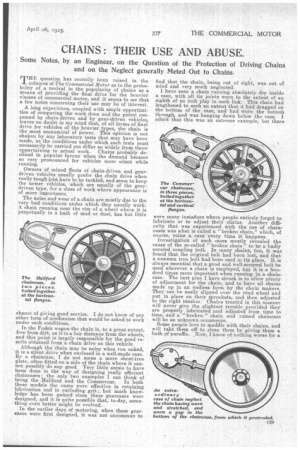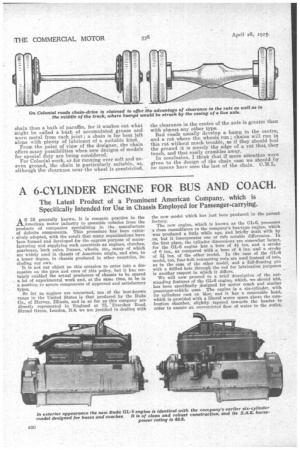CHAINS : THEIR USE AND ABUSE.
Page 13

Page 14

If you've noticed an error in this article please click here to report it so we can fix it.
Some Notes, by an Engineer, on the Question of the Protection of Driving Chains and on the Neglect generally Meted Out to Chains.
T"question has recently been raised in the columns of The Commercial Motor as to the probability of a revival in the popularity of chains as a means of providing the final drive for the heavier classes of commercial motor, and it seems to me that a few notes concerning their use may be of interest.
A long experience, coupled with ample opportunities of comparing the work done and the petrol consumed by chain-driven and by gear-driven vehicles, leaves no doubt in my mind that, of all forms of final drive for vehicles of the heavier types, the chain is the most economical of power. This opinion is not shaken by any laboratory tests that may have been made, as the conditions under which such tests must necessarily be carried out differ so widely from those appertaining to actual work. Chains probably declined in popular favour when the demand became so very pronounced for vehicles more silent while running.
Owners of mixed fleets of chain-driven and geardriven vehicles usually prefer the chain drive when really tough jobs have to be tackled, and seem to keep the newer vehicles, which are usually of the geardriven type, for a class of work where appearance is of more importance.
The noise and wear of a chain are mostly due to the very bad conditions under which they usually work. A chain running near the rim of a wheel where it is perpetually in a bath of mud or dust, has but little chance of giving good service. I do not know of any other form of mechanism that would be asked to work under such conditions.
In the Foden wagon the chain is, to a great extent, free from dirt, as it is a fair distance from the wheels, and this point is largely responsible for the good results obtained from a chain drive on this vehicle.
Although the chain may be noisy when run naked, it is a silent drive when enclosed in a well-made case. By a chaincase' I do not mean a mere sheet-iron plate, often fitted on a side of the chain where it cannot possibly do any good. Very little seems to have been done in the way of designing really efficient chaineases ; the only two examples I can think of being the Hallford and the Commercar. In both these models the cases were effective in retaining lubrication and in excluding grit but much knowledge has been gained since these gearcases were designed, and it is quite possible that, to-day, something even better might he evolved.
In the earlier days of motoring, when these geareases were first designed, it was not uncommon to find that the chain, being out of sight, was out of mind and very much neglected. I have seen a chain running absolutely dry inside a case, with all its joints worn to the extent of an eighth of an inch play in each link. This chain had lengthened to such an extent that it had dragged on the bottom of the case, and had worn the bottoin through, and was hanging down below the case. I admit that this was an extreme example, but there were many instances where people entirely forgot to lubricate or to adjust their chains. Another difficulty that was experienced with the use of chaincases was what is called a "broken chain," which, of course, ruins a case every time it happens.
Investigation of such cases mostly revealed the cause of the so-called " broken chain' to be a badly secured coupling bolt. In many chains, too, it was found that the original bolt had been lost, and that a common iron bolt had been used in its place. It is always essential that a good and well-secured bolt be used wherever a chain is employed, but it is a hundred times more important when running in a chaincase. The best plan I have struck is to allow plenty of adjustment for the chain, and to have all chains made up in an endless form by the chain makers. They can be easily slipped over the road wheel and put in place on their sprockets, and then adjusted to the right tension. Chains treated in this manner will never give the slightest trouble provided they are properly lubricated and adjusted from time to time, and a " broken " chain and ruined chaincase will be an unknown occurrence.
Some people love to meddle with their chains, and will take them off to dean them by giving them a bath of paraffin. Now, I know of nothing worse for a chainthan a bath of paraffin, for it washes out what a might be called bush of accumulated grease and e worn metal from each joint; a chain is far best left alone with plenty of lubricant of a suitable kind. From the point of view of the designer, the chain offers many possibilities when new designs of models for special duty are being considered. For Colonial work, or for running over soft and uneven ground, the chain is particularly suitable, as, although the clearance near the wheel is constricted, the clearance in the centre of the axle is greater than with almost any other type. Bad roads usually develop a hump in the centre, and a rut where the wheels run; chains will run in this rut without much trouble, as if they should foul the ground it is merely the edge of a rut that they touch, and that easily crumbles away. In conclusion, I think that if more attention were given to the design of the chain case we should by no means have seen the last of the chain. C.M.L.
































